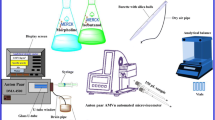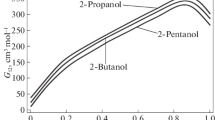Abstract
Thermodynamic properties of binary mixtures of 2-methylcyclohexanol with morpholine are measured as a function of composition and temperature. The excess molar volumes were calculated by experimental data. The excess molar volumes are negative over the entire mole fractions. Density functional theory and molecular dynamics (MD) simulation were used to determine the microscopic structure of this mixture in the gas and liquid phases, respectively. In addition, the quantum theory of atoms in molecules was applied to analyze hydrogen-bonding interactions. From MD simulation, density, radial distribution functions, and combined distribution functions of the mixtures with different mole fractions at 298.15 K and 1.0 atm were calculated.











Similar content being viewed by others
Data availability
All data generated or analyzed during this study are included in this published article.
References
Weinhold F, Arunan E, Desiraju GR, Klein RA (2011). Pure Appl. Chem 83:1637–1641
Biedermann F, Schneider HJ (2014). Chem Rev 116:5216–5300
Larson JW, McMahon TB (1984). Inorg. Chem. 23:2029–2033
Legon AC, Millen DJ (1987). Chem Soc Rev 16:467–498
Grabowsk SJ (2006) Hydrogen bonding: new insights. Springer
Jeffrey GA, Saenger W (2012) Hydrogen bonding in biological structures. Springer
Steiner T (2002). Ang Chem Int Edn 41:48–76
Sánchez O (2019). Molecules 24:1–4
Shakila A, Ravikumar S, Raveendra M, Sivakumar K, Raju R, Pandiyan V (2019). Phys Chem Liq 57:117–136
Francesconi R, Comelli F (1999). J Chem Eng Data. 44:44–47
Löwen B, Schulz S (1995). Thermochim Acta 262:69–82
Padro JA, Saiz K, Guardia E (1997). J Mol Struct 416:243–248
Wu HS, Locke WE, Sandler SI (1991). J Chem Eng Data 36:127–130
Desai MN, Shah CB, Desai YB, Desai SM (1969). British Corrosion Journal. 4:315–317
EPA Chemical and Products Database (CPDat), 2-methylcyclohexanol, mixed isomers. Address: https://comptox.epa.gov/dashboard/dsstoxdb/results?search=DTXSID90862235#exposure
Perryman AL, Zhang Q, Soutter HH (2010). Chem Biol Drug. 75:257–268
Domańska U, Marciniak M (2004). Ind Eng Chem Res 43:7647–7656
Weinhold F, Klein R (2014). Chem Educ Res Pract 15:276–285
Jacobsen EN, Knowles RR (2010). Proc Natl Acad Sci 107:20678–20685
Jacobsen EN, Taylor MS (2006). Ang Chem Int Edn 45:1521–1539
Jeffrey GA (1997) An introduction to hydrogen bonding. Oxford University Press, New York
Azizian S, Bashavard N (2005). J Adv Colloid Interface Sci. 286:349–354
Maham Y, Boivineau M, Mather AE (2001). J Chem Thermodynamics 33:1725–1734
Sharma S, Makavana M (2014). Fluid Phase Equilibria 375:219–227
Frisch MJ, Trucks GW, Schlegel HB, Scuseria GE, Robb MA, Cheeseman JR, Scalmani G, Barone V, Mennucci B, Petersson GA, Nakatsuji H, Caricato M, Li X, Hratchian HP, Izmaylov AF, Bloino J, Zheng G, Sonnenberg JL, Hada M, Ehara M, Toyota K, Fukuda R, Hasegawa J, Ishida M, Nakajima T, Honda Y, Kitao O, Nakai H, Vreven T, Montgomery JA, Peralta JE, Ogliaro F, Bearpark M, Heyd JJ, Brothers E, Kudin KN, Staroverov VN, Kobayashi R, Normand J, Raghavachari K, Rendell A, Burant JC, Iyengar SS, Tomasi J, Cossi M, Rega N, Millam JM, Klene M, Knox JE, Cross JB, Bakken V, Adamo C, Jaramillo J, Gomperts R, Stratmann RE, Yazyev O, Austin AJ, Cammi R, Pomelli C, Ochterski JW, Martin RL, Morokuma K, Zakrzewski VG, Voth GA, Salvador P, Dannenberg JJ, Dapprich S, Daniels AD, Farkas O, Foresman JB, Ortiz JV, Cioslowski J, Fox DJ (2009) Gaussian 09 revision A02. Gaussian, Inc., Wallingford
Becke AD (1992). J Chem Phys 96:2155–2160
Lee C, Yang W, Parr RG (1988). Phys Rev B 37:785–789
Alper TC, Thijs JHV, Othonas AM (2019). J Phys Chem B 123:11014–11025
Weiner SJ, Kollman PA, Case DA (1984). J Am Chem Soc 106:765–784
Cornell WD, Cieplak P, Bayly CI (1995). J Am Chem Soc 117:5179–5197
Brooks BR, Bruccoleri RE, Olafson BD (1983). J comput Chem 4:187–217
Jorgensen W, Maxwell D, Tirado J (1996). J Am Chem Soc 118:11225–11236
Fonseca TL, Coutinho K, Canuto S (2010). Phys Chem Chem Phys 12:6660–6665
Kosztolányi T, Bakó I, Pálinkás G (2003). J Chem Phys 118:4546–4555
Jorgensen WL (1986). J Phys Chem 90:1276–1284
Gao J, Habibollazadeh D, Shao L (1995). J Phys Chem 99:16460–16467
Guevara G, Nieto C, Vrabec J (2008). J Phys Chem B 112:16664–16674
Jorgensen WL, Chandrasekhar J, Madura JD (1983). J Chem Phys 79:926–935
Jorgensen WL, Madura JD, Swenson CJ (1984). J Am Chem Soc 106:6638–6646
Briggs JM, Nguyen TB, Jorgensen WL (1991). J Phys Chem 95:3315–3322
Leeuwen ME, Smit B (1995). J Phys Chem 99:1831–1833
Rizzo RC, Jorgensen WL (1999). J Am Chem Soc 121:4827–4836
Smith W, Forester T, Todorov I (2006) The DL poly 2 user manual. CCLRC, Daresbury Laboratory, Daresbury, Warrington WA4 4AD
Ranjbar S, Soltanabadi A, Fakhri Z (2017). J Mol Liq 234:342–352
Ranjbar S, Soltanabadi A, Fakhri FZ (2016). J. Chem. Eng. Data. 61:3077–3089
Biegler F (2000) AIM2000 University of Applied Sciences, Bielefeld
Carroll MT, Chang C, Bader RF (1988). Mol Phys 63:387–405
Schmidt MW, Baldridge KK, Boatz JA (1993). J comput Chem 14:1347–1363
Biegler F, Schonbohm J, Bayles D (2002). J Comput Chem 23:1489–1494
Alavi S, Shin K, Ripmeester JA (2015). J Chem Eng Data 69:389–397
Bondi A (1964). J Phys Chem 68:441–451
Brehm M, Kirchner B (2011) TRAVIS-a free analyzer and visualizer for Monte Carlo and molecular dynamics trajectories. ACS Publications
Acknowledgments
The authors would like to thank the Research Council of Razi University for providing the necessary facilities for performing the research. Cluster computing times, provided in part by the High Performance Computing Research Laboratory of Institute for Research in Fundamental Sciences (IPM), are greatly acknowledged.
Funding
No funds, grants, or other support was received.
Author information
Authors and Affiliations
Contributions
All authors contributed to the study conception and design. A.S., R.M., and S.R. performed material preparation, data collection, and analysis. Z.F. wrote the first draft of the manuscript and all authors commented on previous versions of the manuscript. All authors read and approved the final manuscript.
Corresponding author
Ethics declarations
Conflict of interest
The authors declare no competing interests.
Ethical approval
This article does not contain any studies involving animals performed by any of the authors.
Consent to participate
This article does not contain any studies involving animals performed by any of the authors.
Consent to publish
All the authors mentioned in the manuscript have given consent for submission and subsequent publication of the manuscript.
Additional information
Publisher’s note
Springer Nature remains neutral with regard to jurisdictional claims in published maps and institutional affiliations.
Supporting information
ESM 1.
The Compound Name, CAS Number, Molar Mass, Supplier and Purity of 2‒Methylcyclohexanol and Morpholine, Details force field, thermal expansion coefficient, α, and isothermal coefficient of pressure excess molar enthalpy, \( {\left(\partial {H}_{\mathrm{m}}^{\mathrm{E}}/\partial P\right)}_{T,{x}_1} \), and optimized coordinates are presented in the supplementary material. (DOCX 111 kb)
Rights and permissions
About this article
Cite this article
Mirzaee, R., Soltanabadi, A., Ranjbar, S. et al. The role of hydrogen bonds in thermodynamic and structural properties in binary mixtures of morpholine + 2-methylcyclohexanol: a combined experimental and computational study. Struct Chem 32, 2319–2332 (2021). https://doi.org/10.1007/s11224-021-01808-9
Received:
Accepted:
Published:
Issue Date:
DOI: https://doi.org/10.1007/s11224-021-01808-9




